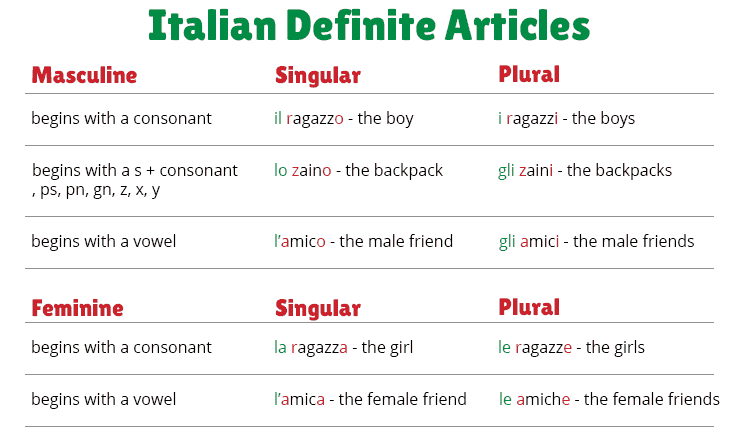What is a definite article?
The definite article, in Italian articolo determinativo, is the part of the speech that introduces and defines a noun.
While in English The is the only definite article, in Italian there are seven different forms to express the definite article.
That happens because the article needs to agree in gender (masculine or feminine) and number (singular or plural) with the noun.
What article to use depends not only on the gender and number, but also on how the word that follows it starts.

italian definite articles chart
Here is an Italian definite articles chart for you to review :
How to decide which definite article to use in Italian?
In order to decide which article to use we need to see if the word that follows it:
- Is masculine or feminine
- Is singular or plural
- Starts with a vowel, a consonant or a group of consonants.
The last point is related to pronunciation and musicality.
My suggestion would be to always learn the word with the corresponding article.
Masculine
The Italian definite articles for masculine nouns are il, lo and l’.
Their corresponding plural forms are i for il and gli for lo and l’.
IL
Italians use il with most masculine singular nouns starting with a consonant.
Examples:
- il ragazzo – the boy
- il panino – the sandwich
- il biscotto – the cookie
I
In Italian i is the definite article to use in front of masculine plural nouns starting with a consonant. I is the plural form of il.
Examples:
- i ragazzi – the boys
- i panini – the sandwiches
- i biscotti – the cookies
L’
L’ is used for both masculine and feminine singular nouns starting with a vowel.
- l’amico – the (male) friend
- l’amica – the (female) friend
- l’albero – the tree
LO
Lo is used before masculine singular nouns starting with s+consonant, ps, pn, gn, z, x, y.
Examples:
- lo zaino – The backpack
- lo studente – the student
- lo gnomo – the dwarf
- lo psicologo – the psychologist
- lo yogurt – the yogurt
- lo xilofono – the xylophone
GLI
Gli is used is front of masculine plural nouns starting with s+consonant, ps, pn, gn, z, x, y or a vowel. Gli is the plural form of lo and l’ (masculine).
- gli zaini – the backpacks
- gli studenti – the students
- gli gnomi – the dwarfs
- gli psicologi – the psychologists
- gli yogurt – the yogurts
- gli amici – the (male) friends
Feminine
Choosing the definite article for the feminine is much easier.
LA
Italians use la for feminine singular nouns starting with a consonant.
Examples:
- la ragazza – the girl
- la studentessa – the (female) student
- la psicologa – the (female) psychologist
- la mela – the apple
- la rana – the frog
NOTE: Italians drop the -a of the article if the word starts with a vowel:
Examples:
- l’amica – the (female) friend
- l’amaca – the hammock
- l’invasione – the invasion
- l’estate – the summer
LE
The plural feminine has only one form: le
Examples:
- le ragazze – the girls
- le studentesse – the (female) students
- le psicologhe – the (female) psychologists
- le mele – the apples
- le amiche – the (female) friends
- le rane – the frogs
- le amache – the hammocks
- le invasioni – the invasions
- le estati – the summers
NOTE: The definite article can be followed by an adjective as well. Remember that the form of the article depends on the first letters of the word that follows it.
- L’amico – the friend
- Il migliore amico – the best friend
In the second example we are using the definite article il because the word amico is masculine singular and because the word that comes right after it (migliore) starts with a consonant.
When to use the definite article?
The definitive article is used much more in Italian than in English.
It is used in the following situations:
- To indicate a person or a thing that is known by the people involved in the conversation.
Examples:
Il negozio al centro è carino.
The shop in the town centre is cute.La ragazza è intelligente.
The girl is smart. - When talking about something that was introduced before.
Examples:
Voglio un libro. Il libro deve essere interessante.
I want a book. The book has to be interesting.La domanda non è pertinente.
The question is not relevant. - In referring to people or things that are unique.
Examples:
Il papa vive a Roma.
The pope lives in Rome.Il sole scotta oggi!
The sun is hot today!Chi è il presidente della Repubblica Italiana?
Who is the president of the Italian Republic? - To indicate the whole group of species of beings or things.
Examples:
L’essere umano è evoluto.
The human being is evolved (meaning every human being).Il delfino è un animale intelligente.
The dolphin is a clever animal (meaning all dolphins).Le posate sono nel cassetto.
Silverware is in the drawer. - It is used with the days of the week or parts of the day to indicate a repeated activity.
Example:
Mangio tanto la domenica.
I eat a lot on Sundays.La sera guardo la TV prima di andare a letto.
Every evening I watch TV before going to bed. - Italians use it to say what time it is.
Example:
Sono le 8:00.
It’s 8:00.The article le in front of the time comes from le ore (the hours) which is feminine plural for l’ora (the hour).
Sono le 8:00.
It’s 8:00.È l’ (ora) 1:00.
It’s 1:00. - To say the dates and years.
Examples:
Oggi è il 5 luglio.
Today is the 5th of July.Il 2019 è quasi finito.
2019 is almost over. - Before names of countries, regions, states, continents, big islands, mountains, rivers, seas.
Examples:
L’Italia è molto bella.
Italy is beautiful.Le Dolomiti sono alte.
The Dolomites are high.La Sicilia è un’isola affascinante.
Sicily is a charming island.Il Mediterraneo si trova tra l’Europa, il Nord Africa e l’Asia Occidentale.
The Mediterranean Sea is in between Europe, North Africa and West Asia.A Roma c’è il Tevere.
In Rome there is the Tiber River.NOTE: The definite article is not used if the name of the country or region is preceded by the preposition in (which can mean in or to).
Example:
Vado in Italia ogni anno.
I go to Italy every year. - With cardinal points (North, South, Est, West) and parts of a place.
Examples:
Il nord e il sud e il centro Italia.
The North, the South and the Center of Italy.
Quello è il Nord.
That is the North. - With the possessive adjectives (my, your, their…)
Examples:
Il mio orologio – My watch
I tuoi cugini – Your cousins
La loro casa – Their houseNOTE: Italians don’t use the definite article with nouns referring to members of the family at the singular form.
Examples
Mia madre – my mother
Tuo cugino – your cousins - With languages.
Examples:
L’italiano è una lingua bellissima.
Italian is a very beautiful language.Imparare l’italiano è facile.
Learning Italian is easyNOTE: Italians don’t put the article in front of the languages if a verb like parlare (to talk, to speak) or dire (to say) is used.
Examples:
Parlo italiano
I speak ItalianDillo in italiano!
Say it in Italian! - With sports.
Examples:
Il calcio è sopravvalutato
Soccer is overestimatedNon mi piace il tennis
I don’t like tennisNOTE: In Italian it isn’t used the definite article when saying that you are playing a sport.
Example:
Gioco a calcio
I play soccer.
Regional Use of the Definite Article
The definite article is not used with proper names of persons.
Examples:
- Lucia
- Francesco
- Antonio
However in some regions of Northern Italy it is common to hear the article before the name in informal situations.
Examples:
- La Lucia
- Il Francesco
- L’Antonio
Other uses of the Italian definite article
The definite article can be used in front of every other part of the speech (adjectives, adverbs, verbs, pronouns,..) and transform it into a noun.
Examples:
- il bene – the good
- il sapere – the knowing
- il loro e il voi – the they and the you
Conclusion
I understand this is a lot to remember, with time it will come natural, especially if you start learning the definite article along with all the new Italian words that you will add into your Italian vocabulary.
And if at the beginning you use the wrong definite article, or even if you forget it, don’t worry, as long as the noun is right, Italians will still be able to understand what you mean and eventually help you.



